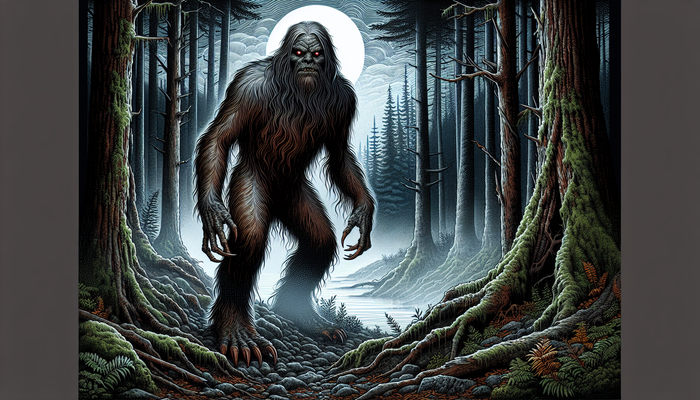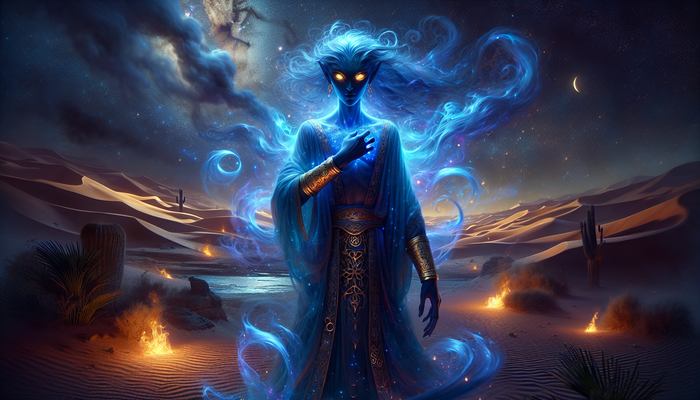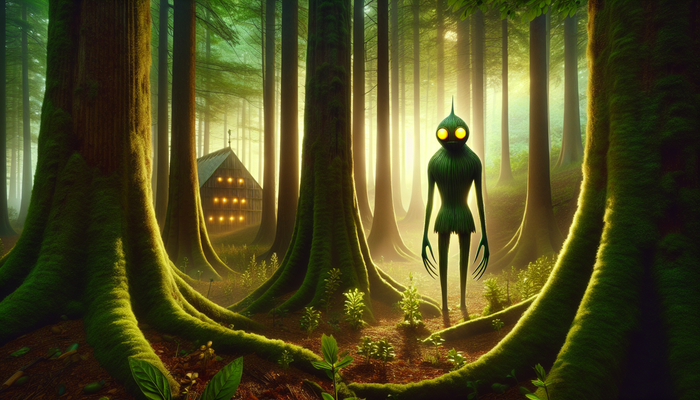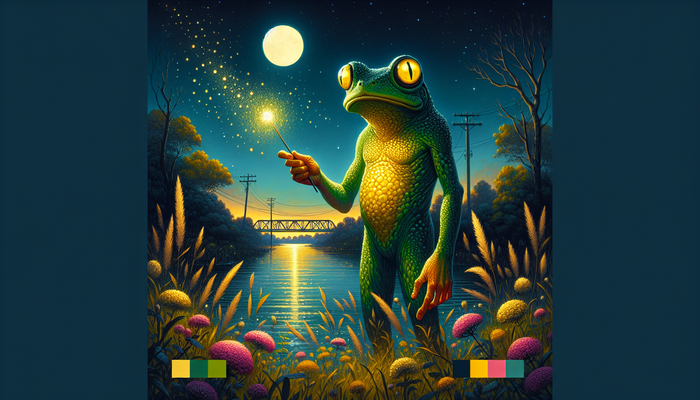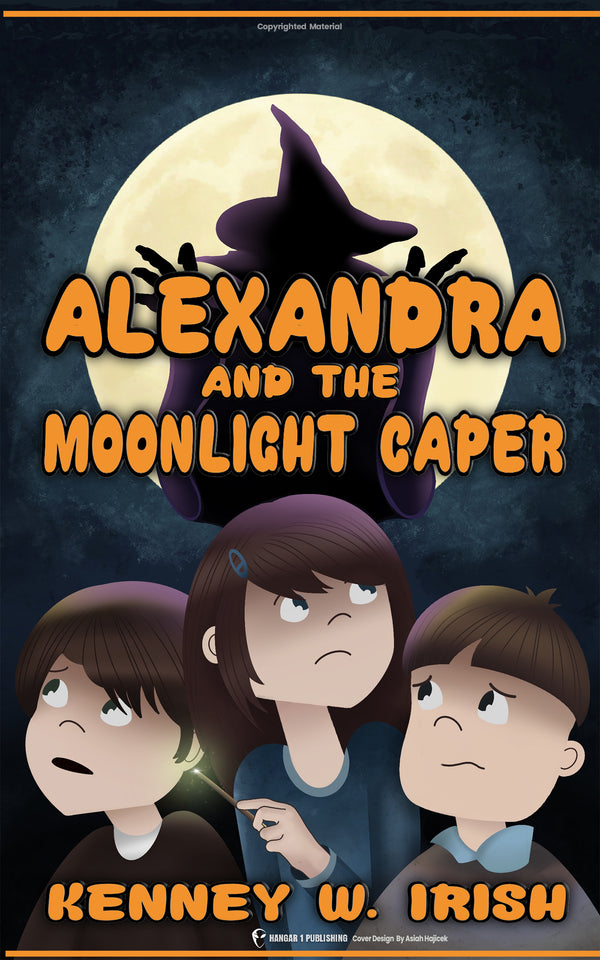The Bat Beast of Kent: A Mysterious Winged Cryptid Encounter
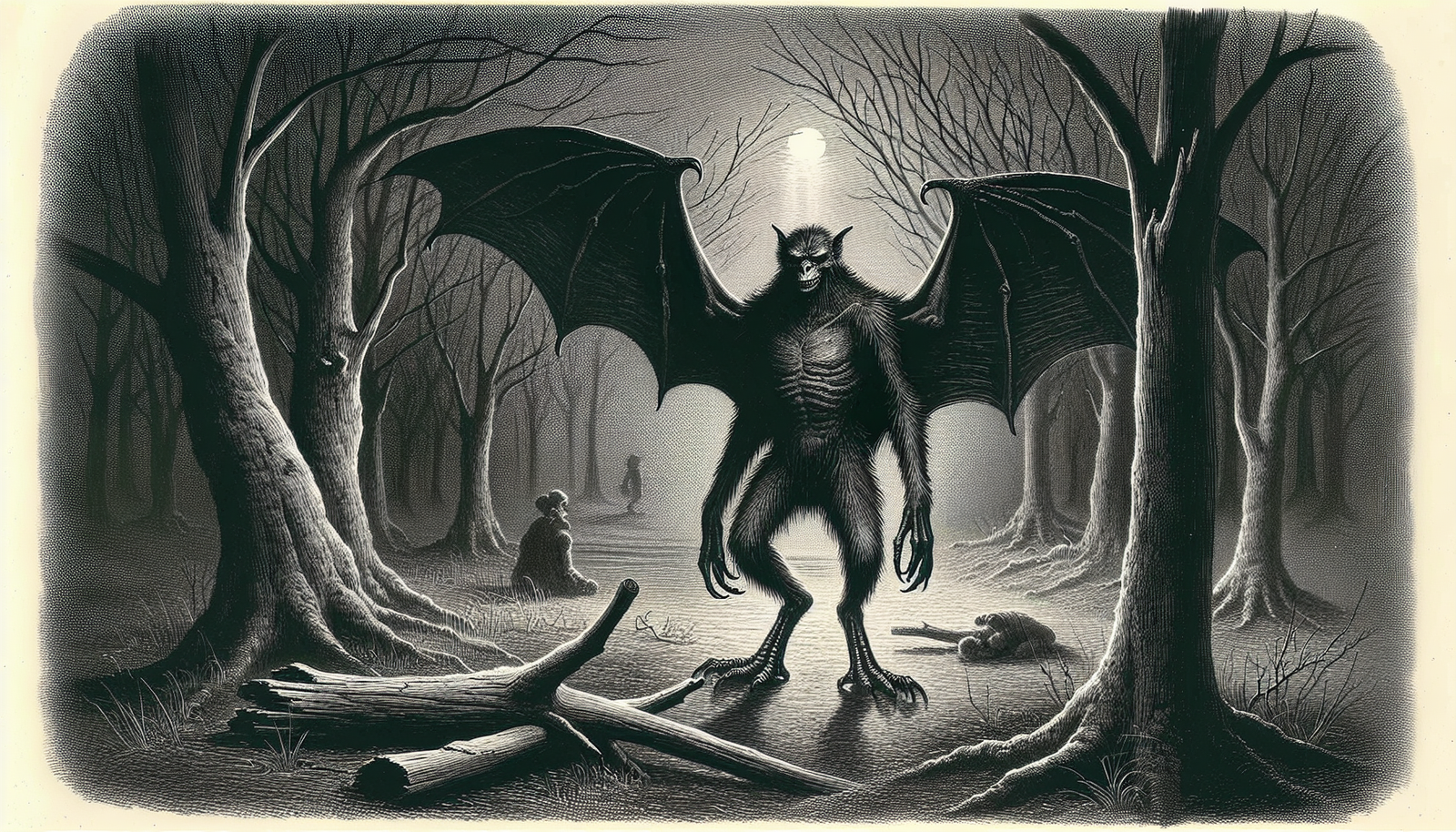
By James Roberts, Cryptozoologist
It's a chilly November evening in the quaint English countryside of Kent. A group of teenage friends are walking home from a party, laughing and chatting, their breath visible in the crisp autumn air. Suddenly, their carefree banter is interrupted by an unbelievable sight in the sky above - a large, glowing orb hovering over a nearby field.
As the awestruck teens watch, the eerie craft descends behind a clump of trees, seemingly landing somewhere in the shadowy woods. Curiosity overtakes caution, and the plucky youths venture to the edge of the treeline to investigate. But what emerges from those woods is beyond their wildest imaginings - a nightmarish winged humanoid, with leathery bat wings, webbed feet, and most shockingly, no head on its hairy shoulders.
This spine-chilling encounter, which took place on the night of November 16, 1963, has become known as the Bat Beast of Kent - one of the most bizarre and perplexing cases in the annals of cryptozoology. The creature's appearance, and its apparent link to an anomalous UFO sighting, have captured the imaginations of researchers and enthusiasts for nearly six decades, yet the mystery remains unsolved.
In this article, we'll take a deep dive into the baffling case of the Bat Beast, examining the eyewitness accounts, the subsequent investigations, the rampant media coverage, and the many lingering questions. We'll explore the various theories that have been put forth to explain the creature's origins and nature, and consider its place in the pantheon of winged humanoid cryptids reported around the world.
So join me as we journey back to that fateful night, and try to unravel the enduring enigma of the Bat Beast of Kent. Strap in, because this is one wild ride.
The Sighting
Our story begins on the evening of November 16, 1963, in the picturesque county of Kent in southeastern England. Four teenage friends - 17-year-old John Flaxton, 18-year-old Mervyn Hutchinson, and two other unnamed youths - were walking home along Sandling Road after a night of revelry at a local party. Little did they know that their carefree walk was about to take a terrifying turn.
As the group made their way down the road, something strange caught their eye in the sky above. Hovering over a field adjacent to their path was a large, luminous object, described as oval or egg-shaped in appearance. The teens estimated it to be a few meters in diameter, and noted that it seemed to be glowing or self-illuminated.
Eerily, the unidentified craft was completely silent, ruling out the possibility of it being a helicopter or airplane. The awestruck group watched in amazement as the UFO slowly descended, sinking below the treeline and apparently coming to rest somewhere in the woods of nearby Sandling Park.
Perplexed but undeterred, the adventurous youths decided to investigate. They made their way to the edge of the park, but could see no sign of the mysterious orb. Then, just moments later, their curiosity turned to horror.
The teens heard a disturbance in the brush, the snapping of twigs and rustling of leaves. They peered into the darkness, trying to make out the source of the commotion. Suddenly, a figure emerged from the woods, waddling towards them in the moonlight. But this was no ordinary intruder.
The creature, which would come to be known as the Bat Beast of Kent, was a sight straight out of a nightmare. It stood around 5 feet tall, with a pair of huge, leathery wings protruding from its back like those of a giant bat. The beast was covered in hair or fur, adding to its animalistic appearance.
But most disturbing of all was the fact that the entity seemed to have no discernible head sitting atop its shoulders. Where one would expect to find a face, there was nothing but a smooth, featureless expanse of skin or hide.
As if the wings and missing head weren't strange enough, the creature also sported a pair of webbed feet, like those of a duck or some aquatic bird. This bizarre amalgamation of features left the teens utterly baffled and terrified.
Mervyn Hutchinson, one of the witnesses, later recalled the spine-chilling sight in an interview. "It didn't seem to have any head," he said. "There were huge wings on its back… like bat wings."
Overwhelmed with primal dread, the petrified group turned and sprinted away from the freakish bat-thing as fast as their legs could carry them. They ran non-stop until they reached the nearest police station, where they breathlessly related their disturbing tale to the authorities.
John Flaxton, another of the teenage eyewitnesses, described an overwhelming physical sensation that accompanied the sighting. He claimed that he had "felt cold all over" during the encounter, as if the creature's mere presence had drained all warmth from his body.
Unsurprisingly, the police officers were highly skeptical of the teens' wild story. After all, who had ever heard of a headless, winged humanoid stalking the Kent countryside? The cops likely chalked the whole thing up to overactive imaginations, or perhaps a prank taken too far.
But little did they know that this would be far from the last anyone would hear of the Bat Beast of Kent. The sighting on Sandling Road was only the beginning of a mystery that would endure for decades, captivating researchers and baffling skeptics alike.
Aftermath and Investigation
In the days following the Sandling Road incident, the Bat Beast of Kent began to attract attention beyond the confines of the local police station. While the authorities may have been quick to dismiss the teens' fantastical tale, others in the community were not so easily dissuaded.
The first piece of corroborating evidence came less than a week after the initial sighting. On November 21st, a young man named Keith Croucher came forward with a startling report of his own. Croucher claimed that he too had witnessed an anomalous object in the skies over Kent, describing it as an "oddly-shaped craft" hovering above a soccer field not far from the site of the teenagers' encounter.
This independent account seemed to confirm that the teens had indeed seen something out of the ordinary on that fateful night. If Croucher was to be believed, then the strange craft sighted over Sandling Road was no mere figment of their imaginations.
But it wasn't just the UFO sighting that would find support in the days to come. The creature itself, in all its bizarre glory, would soon be subject to further investigation by an intrepid local man named John McGoldrick.
McGoldrick, a curious and courageous individual, decided to take it upon himself to investigate the scene of the encounter. On November 23rd, he and a friend made their way to the woods of Sandling Park, determined to uncover any evidence that might shed light on the teens' story.
What they found there was nothing short of astonishing. As the two men explored the area where the Bat Beast had been sighted, they stumbled upon three massive footprints embedded in the soft earth of the forest floor. Each print measured a whopping 24 inches in length and 9 inches in width - far larger than any human foot, and suggestive of a truly monstrous creature.
But the footprints weren't the only anomaly McGoldrick and his companion discovered that day. Nearby, they found a patch of bracken ferns that had been mysteriously flattened, as if a large, heavy body had trampled across it. This further supported the idea that something massive and unknown had passed through the woods that night.
Armed with this incredible new evidence, McGoldrick went to the local press with his findings. His story quickly caught the attention of reporters, who were eager to investigate the strange goings-on in Kent. On December 11th, McGoldrick returned to Sandling Park, this time with a cadre of journalists in tow.
While no new footprints or physical evidence were uncovered during this follow-up investigation, the reporters did note one peculiar detail. The area where the creature had been sighted seemed to be bathed in an eerie, inexplicable glow, which persisted for several days after their visit. This only added to the sense of mystery and otherworldliness surrounding the case.
As word of the Bat Beast spread, the story began to generate significant media attention both in Kent and beyond. Local newspapers ran article after article about the bizarre sighting, interviewing witnesses and speculating about the creature's origins.
The public, it seemed, was captivated by the idea of a winged, headless monster stalking the English countryside. People began to trade theories and rumors, wondering if the beast was some sort of undiscovered animal, an extraterrestrial visitor, or perhaps even a supernatural entity.
In 1971, the Bat Beast of Kent gained even wider exposure when it was featured in the pages of Flying Saucer Review, a popular magazine dedicated to UFOs and the paranormal. There, it was dubbed the "Saltwood Mystery," after the nearby village of Saltwood.
For many readers, the case represented a fascinating convergence of cryptozoology, ufology, and the paranormal. The fact that the creature had been sighted in close proximity to a UFO landing site suggested a possible link between the two phenomena - a connection that would tantalize researchers for years to come.
But as the media frenzy surrounding the Bat Beast reached a fever pitch, skeptics began to emerge from the woodwork, offering alternative explanations for the sighting. These ranged from the mundane to the downright bizarre, but all sought to cast doubt on the idea that a genuine anomaly had been witnessed that night in Kent.
Theories and Explanations
As with any extraordinary claim, the case of the Bat Beast of Kent has attracted its fair share of skeptics and debunkers over the years. These naysayers have put forth a variety of theories to explain away the sighting, ranging from the plausible to the preposterous.
One of the most prominent skeptical voices in the Bat Beast saga is that of Chris Wolfe, a ufologist who reinvestigated the case in the 1970s. Wolfe interviewed John Flaxton, one of the original teenage eyewitnesses, and visited the site of the encounter in an effort to shed new light on the mystery.
After examining the evidence and speaking with Flaxton, Wolfe came to a rather mundane conclusion. In his estimation, the creature that the teens had seen that night was nothing more than an ordinary crow, its features distorted and exaggerated by the play of light and shadow.
According to Wolfe's theory, the bird's silhouette had been oddly illuminated by the headlights of a passing train, creating the illusion of a much larger, more monstrous form. He argued that the teens, already in a state of heightened excitement and fear after seeing the strange light in the sky, had simply misinterpreted this visual trick as a headless, winged humanoid.
However, there are several glaring issues with Wolfe's explanation. For one, it fails to account for the creature's reported size of around 5 feet tall - far larger than any known species of crow. It also doesn't address the beast's apparent lack of a head, or the presence of webbed feet, which are not features typically associated with birds.
Furthermore, Wolfe's theory does not explain the corroborating UFO sighting reported by Keith Croucher just a few days after the Sandling Road incident. If the teens had simply been spooked by a crow, then what are we to make of the anomalous craft seen hovering over a nearby soccer field?
Other skeptics have put forth even more outlandish suggestions, such as the idea that the teens simply encountered an ordinary scarecrow that night. But again, this fails to align with the specific details of the creature's description, not to mention its reported movement and behavior.
Despite these attempts at debunking, the case of the Bat Beast has remained a source of fascination and mystery for researchers and enthusiasts alike. Many have noted the striking similarities between the Kent creature and other anomalous entities reported around the world, particularly those falling into the category of "winged humanoids."
Perhaps the most famous of these is the Mothman, a red-eyed, winged being that terrorized the town of Point Pleasant, West Virginia in the mid-1960s. Like the Bat Beast, the Mothman was often sighted in close proximity to UFO activity, and was said to possess an otherworldly, almost supernatural aura.
Other analogous creatures include the Freiburg Shrieker of Germany, the Man-Dragon of China, and the Black Bird of Chernobyl, which haunted the ruins of the infamous nuclear disaster site in the former Soviet Union. These entities, while distinct in their own ways, all share certain key characteristics with the Bat Beast - namely, a humanoid form combined with avian or chiropteran features.
Some researchers have suggested that these creatures may represent a previously unknown species of animal, perhaps a relic population of some prehistoric beast that has managed to survive into modern times. Others believe they could be extraterrestrial in origin, visitors from another world that have taken on a form that is only partially compatible with our own biology.
Still others see these winged humanoids as paranormal entities, manifestations of some otherworldly intelligence that defies our understanding of the natural world. Many cultures throughout history have associated winged beings with omens and portents, viewing them as messengers or harbingers of impending doom.
In this light, some have speculated that the Bat Beast and its ilk may serve a similar purpose, appearing in times of great upheaval or change to warn of coming disasters or shifts in the fabric of reality itself. The fact that many of these creatures seem to be accompanied by UFO activity only deepens the sense of mystery and suggests a possible link between the worlds of cryptozoology and ufology.
But there is one aspect of the Bat Beast case that sets it apart from other winged humanoid sightings, and that is its direct connection to a UFO landing event. In most other instances, the creatures are seen in the same general area as anomalous lights or objects in the sky, but rarely is there such a clear and compelling link between the two phenomena.
The fact that the Bat Beast emerged from the woods just moments after a strange craft was seen descending into the very same area is highly suggestive of a relationship between the entity and the UFO. It's as if the beast was a passenger or crew member aboard the craft, disembarking to explore the surrounding countryside after landing.
This tantalizing detail has led some researchers to speculate that the Bat Beast may represent a genuine alien life form, a being from another world that was visiting our planet for unknown reasons. If this is the case, then the Kent sighting could be one of the most compelling pieces of evidence for the existence of extraterrestrial intelligence ever recorded.
Of course, without further proof, such ideas remain firmly in the realm of speculation. The true nature of the Bat Beast, like that of so many other cryptozoological mysteries, continues to elude us, lost in the mists of time and the vagaries of human memory.
But one thing is certain - the legacy of this bizarre entity lives on, captivating new generations of researchers and enthusiasts with each passing year. Whether it was a flesh-and-blood creature, an extraterrestrial scout, or something altogether more esoteric, the Bat Beast has earned its place in the annals of the unexplained.
From Bigfoot to UFOs: Hangar 1 Publishing Has You Covered!
Explore Untold Stories: Venture into the world of UFOs, cryptids, Bigfoot, and beyond. Every story is a journey into the extraordinary.
Immersive Book Technology: Experience real videos, sights, and sounds within our books. Its not just reading; its an adventure.


